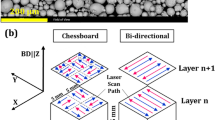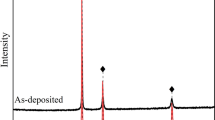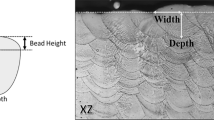Abstract
Long-term 1093 K heat treatments of three commercial superalloy sheet materials were undertaken in air and vacuum. With either exposure, significant precipitation of second phases occurred in the Co-base Haynes® Alloy 188 (HA 188) and the Ni-base Haynes® Alloy 230 (HA 230); however, much less precipitation was found in the exposed Ni-base alloy Inconel® 617 (IN 617). Although some grain growth occurred in HA 188, no changes in the grain size of either HA 230 or IN 617 were observed after 22,500 h at temperature. Oxidation during air heat treatments led to weight gain due to the formation of chromia + spinel scales and surface-connected grain boundary pits/oxides in all three superalloys. Both the weight gain and depth of intergranular attack were dependent on the square root of time, which is indicative of diffusion-controlled phenomena. Because many alloy samples had neighbors in close proximity, dmost vacuum heat treated specimens did not suffer significant loss of volatile elements. However, some exposed samples were subjected to unrestricted vacuum heat treatments, allowing estimates of volatilization to be made. Based on the data for HA 188, the weight loss during 1093 K vacuum exposure was diffusion controlled once the inhibiting effects of surface films on the as-received alloys were broken down.
Similar content being viewed by others
References
T.L. Labus, R.R. Secunde, and R.G. Lovely, Solar Dynamic Power Module Design, Paper No. 899277,IECEC ’89, Vol 1,IEEE, 1989, p 299–307
H.J. Strumpf, R.P. Rubley, and M.G. Coombs, Material Compatibility and Simulation Testing for the Brayton Engine Solar Receiver for the NASA Space Station Freedom Solar Dynamic Option,Paper No. 899076,IECEC ’89, Vol 2, IEEE, 1989, p 895–903
R.C. Schulze, NASA CR-54781, 1965
D.T. Bourgette and H.E. McCoy,Trans. ASM, Vol 59, 1966, p 324–339
J.D. Whittenberger,J. Mater. Eng., Vol 12, 1990, p 211–226
J.D. Whittenberger,J. Mater. Eng. Perf., Vol 1, 1992, p 469–482
J.D. Cotton and L.M. Sedgwick, Compatibility of Selected Superalloys with Molten LiF-CaF2 Salt, Paper No. 899235,IECEC ’89, Vol 2, IEEE, 1989, p 917–921
M. Rothman, Haynes International, personal communication
W.L. Mankins, J.C. Hosier, and T.H. Bassford,Metall. Trans.,Vol 5, 1974, p 2579–2590
C.A. Barrett,Environmental Degradation of Engineering Materials,Virginia Polytechnical University, 1977, p 319–327
J.R. Stephens and C.A. Barrett, NASA TM-83609, 1984
P. Ganesan and G.D. Smith,J. Mater. Eng., Vol 9, 1988, p 337–343
D.T. Bourgette, ORNL-TM-13677, 1964
L.A. Chariot and R.E. Westerman,Corrosion, Vol 23, 1967, p 50–56
D.T. Bourgette, ORNL-TM-1786, 1967
Author information
Authors and Affiliations
Rights and permissions
About this article
Cite this article
Whittenberger, J.D. Effect of Long-Term 1093 K Exposure to Air or Vacuum on the Structure of Several Wrought Superalloys. JMEP 2, 745–758 (1993). https://doi.org/10.1007/BF02650066
Issue Date:
DOI: https://doi.org/10.1007/BF02650066




